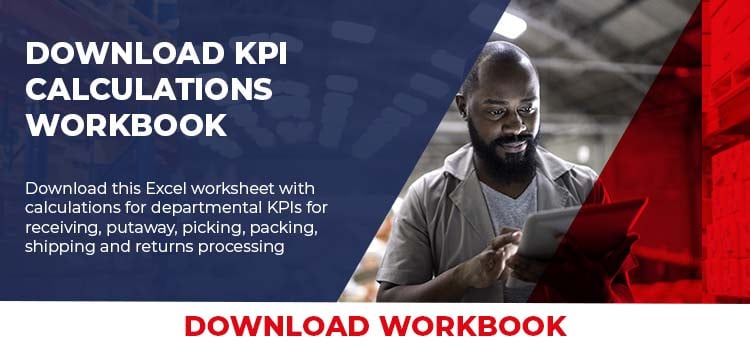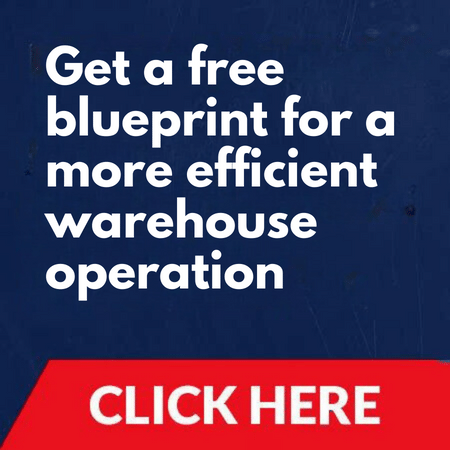 Fulfillment cost per order is the sum of all the warehousing expenses involved with shipping orders, including:
Fulfillment cost per order is the sum of all the warehousing expenses involved with shipping orders, including: - Receiving, inventory putaway, and storing the product.
- Fulfilling orders through picking, packing, shipping.
- Reverse logistics or returns processing from customers.
Historically, many managers only look at the labor portion of the fulfillment cost per order. However, labor only represents 50-60% of the total costs. A fully loaded fulfillment cost per order is a better metric and includes facilities and occupancy costs and packing material costs.
This article discusses how to calculate the fulfillment cost per order, cost per line, and cost per box shipped.
Calculating Fulfillment Cost Per Order
Comparing the cost per order between businesses is difficult because businesses, product, and order profiles vary widely. Fulfillment costs vary depending on the level of automation, technology, and warehouse management systems implemented. This can make comparison of total fulfillment costs difficult between companies. At times, comparing warehouse benchmarking and metrics should be avoided all together.
The best way to compare your fulfillment cost per order is to create internal historical comparisons to show the trends over time.
Data Required to calculate fulfillment cost per order
The following are the basic statistical and cost data elements you’ll need to calculate cost per order:
- Annual net sales dollars – the gross sales, net of returns and exchanges.
- Annual orders shipped – the number of orders fulfilled.
- Total order lines – the total lines on fulfilled orders.
- Annual boxes shipped – the boxes or cartons shipped by the fulfillment center.
- Total direct labor dollars – the cost to complete functions including receiving, putting away, picking, packing, shipping, and returning items required to fill orders.
- Total indirect labor dollars – the cost to complete any warehouse labor function not classified as direct labor. Usually includes support functions, such as supervision, maintenance, clerical, and inventory.
- Total occupancy dollars (fixed CPO) – the facility costs for leases, utilities, amortization and depreciation for material handling, conveyor and sortation, WMS.
- Total packing supplies dollars – the cost of any boxes, envelops and dunnage required to fill orders.

Calculating Fulfillment Cost Per Order
Here are four calculations that every fulfillment company should be measuring long term.- Total warehouse cost per order: total warehouse costs divided by annual orders shipped.
- Total warehouse cost per order line: total warehouse costs divided by total order lines.
- Total warehouse cost per box: total warehouse costs divided by annual boxes shipped.
- Total warehouse cost as a percent of net sales $: total warehouse costs divided by annual net sales in dollars multiplied by 100. Further details about this measure are below.
Metrics to Consider
Labor costsMost likely, more than 50-60% of your cost per order is direct and indirect labor costs. What are you doing to use labor more effectively? We recommend implementing these major strategies that will help you manage warehouse labor effectively while also controlling your warehouse expenses.
Fixed cost per order
When reviewing your warehouse expenses, the fixed cost per order is mostly made up of the total occupancy and storage space defined above. The total occupancy cost represents the costs to store product and fulfill orders until the capacity is totally used. In other words, that fixed expense will be allocated over more orders as the business grows until capacity is used up.
There is also a fixed cost of management overhead for the director of fulfillment and the departmental managers. Their salary and benefit costs can be spread, or allocated, over an increasing number of orders, too. A disciplined internal warehouse assessment and optimization study can shed light on areas for improvement.
Outbound shipping costs
For outbound shipping costs, you will want to calculate the cost per order and box separately from the warehouse costs above.
Outbound shipping costs vary widely between companies. For example, in consumer ecommerce small parcel shipping, the cost of shipping now exceeds all of the other expenses shown above. Adding it into the warehouse expenses distorts any comparison you may wish to make.
Additionally, business to business ecommerce companies, which have larger orders, distributors, and wholesalers, may use LTL. So, a comparison to ecommerce using small parcel shipping is not valid.
Instead, calculate these two additional fulfillment costs:
- Outbound shipping cost per order: the total outbound shipping costs divided by the total orders.
- Outbound shipping cost per box: the total outbound shipping costs divided by total boxes.
Departmental metrics
The above calculations of fulfillment cost per order are helpful when understanding your overall business. Now the challenge is to apply this process to the departmental costs and productivity.
Departmental functions include any major warehouse functions, such as receiving, putaway, picking, packing, shipping and returning items to fill orders and process returns.

To get a meaningful measurement of these costs, you will need to collect data at a much lower level and include paid hours for those activities. We recommend using a timekeeping system that allows measurement of the employee in/out for various departments. Without this, any cross training you have adopted will distort how many transactions, such as orders, lines, and boxes, are processed.
You’ll also want to calculate the paid hours worked in the department from the time collected.
As you start the measurement of department functions, different units of work may be applicable between departments. For example, receiving functions may have little performed inspection compared to other businesses. The number of cases or pallets received rather than units received may be a more meaningful metric.
How does your fulfillment cost per order compare
What are good fulfillment cost per order results? Unfortunately, industry surveys often fail to give accurate and usable results because they average together dissimilar businesses.
If you are going to compare your results to other businesses, it will require considerably more data than we illustrated.
- Did you define cost per order the same way, with the same data elements?
- How does the order profile differ between businesses? For example, consumer ecommerce businesses average less than three lines per order. Business to business will often average far higher. What is the number of lines and units per order average? If you are a consumer apparel ecommerce business, your returns may be 20%. A home décor business may be 8%. Those operating costs affect fulfillment cost per order.
- Labor cost per hour will vary by marketplace and company as much as $3 to $4 per labor hour.
- The level of automation between fulfillment businesses varies. Most are conventional, largely manual operations and are not highly automated. CPO will vary widely where automation has been effectively applied.
Chief Financial Officers often want a convenient ratio to compare fulfillment costs between companies. While a true comparison is likely impossible, the best way to do this is to calculate the fulfillment costs as a percent to net sales.
Percent to net sales = total warehouse costs divided by annual net sales in dollars multiplied by 100.
The danger of this method is that the average order value (AOV) can be widely different between businesses. Generally, this discrepancy is caused by wide differences in average retail price points and average order value. We understand the desire to compare, but it may give a result that is misleading.
Most important fulfillment cost per order measurement
In the end, the most important aspect is creating a historical comparison for your business and adding history to management reporting. Is your productivity measured in dollars and units of work produced improving seasonally and annually?
Many businesses are not. Low unemployment and increasing labor costs, as well as outbound shipping costs, are eroding profits.
Can third-party logistics (3PL) stabilize or lower fulfillment cost per order?
Third-party logistics may benefit your business by helping you maintain high customer service and cost-effective fulfillment applications. While 3PL isn’t for everyone, we have seen companies use 3PL and achieve quality and competitive costs.
Companies using third-party fulfillment will pay an order fulfillment fee for particular services, such as receiving, inventory storage, order processing (pick/pack), and returns processing.
Before deciding if a 3PL is right for you, it is important to compare 3PL fulfillment costs. To get an apples to apples comparison between internal fulfillment and third party, consider all of the cost per order elements.
Summary
Rising labor costs and outbound shipping costs are hurting many companies’ profits. When trying to improve fulfillment cost per order, the best comparison is reviewing your internal operational results historically within your company.
Learn how a warehouse consultant can assist with understanding your costs, as well as other warehouse improvement projects focused on fulfillment service and warehouses assessments.






SHARE